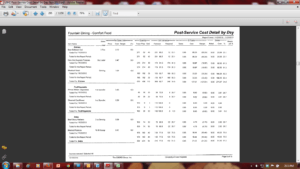Posts by hdcoadmin
Census finds difference in night and day
By Daniel Kelley, The Belleville News-Democrat Filtering through Census data, Belleville News-Democrat discovered cities that experience huge daily growth as commuters arrive from bedroom communities. For example, workers caused the population of Sauget to balloon 10 times its normal size, while the village of Shiloh sees its population drop more than 40 percent each weekday.…
Read MoreBehind the Story: Tracking food waste at a local institution
Forty percent of food grown in the United States goes uneaten, according to the National Institutes of Health. That’s everything from misshapen potatoes left in the field to the half jar of salsa going bad in your refrigerator. Most of us believe wasting food is bad, but many large institutions write off that waste as…
Read MoreMIA work ‘acutely dysfunctional’
“Largely beyond the public spotlight, the decades-old pursuit of bones and other MIA evidence is sluggish, often duplicative and subjected to too little scientific rigor, (an internal military) report says. The Associated Press obtained a copy of the internal study after Freedom of Information Act requests for it by others were denied.”
Read MoreLandlords, self-employed get state aid on honor system
“A (Milwaukee) Journal Sentinel investigation found property owners with major sources of rental income who did not reveal it in applications for public assistance. The cases reveal a gap in regulation that affects every public assistance program in the state. Local and state regulators fail to verify actual income when applicants report that they make…
Read MoreWalking our roads could kill you
An Orlando Sentinel report states: “Nowhere in America are pedestrians at greater risk of being struck and seriously injured or killed. Nowhere are drivers more likely to suffer the life-changing split second of taking someone’s life — simply by operating one of the 3,000-pound machines that are so ubiquitous in Central Florida life, and so…
Read MoreU.S. Postal Service Logging All Mail for Law Enforcement
“As the world focuses on the high-tech spying of the National Security Agency, (Leslie James Pickering’s) misplaced card offers a rare glimpse inside the seemingly low-tech but prevalent snooping of the United States Postal Service,” a New York Times report states.
Read MoreViolence reverberates through the city, even with decline in shootings, homicides
“It was just one scene in a city where gunfire has long been too common. In the first six months of this year, more than 1,000 people were shot in Chicago, according to a (Chicago) Tribune analysis.”
Read MoreU.S. system for flagging hazardous chemicals is widely flawed
“A 27-year-old U.S. program intended to warn the public of the presence of hazardous chemicals is flawed in many states due to scant oversight and lax reporting by plant owners, a Reuters examination finds.”
Read MoreFemale inmates sterilized in California prisons without approval
“Doctors under contract with the California Department of Corrections and Rehabilitation sterilized nearly 150 female inmates from 2006 to 2010 without required state approvals, The Center for Investigative Reporting has found.”
Read MoreOil Spills: U.S. well sites in 2012 discharged more than Valdez
“It was one of the more than 6,000 spills and other mishaps reported at onshore oil and gas sites in 2012, compiled in a months-long review of state and federal data by EnergyWire. That’s an average of more than 16 spills a day. And it’s a significant increase since 2010. In the 12 states where comparable…
Read More The IRE office will be closed from December 25th to January 5th.
The IRE office will be closed from December 25th to January 5th.
